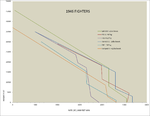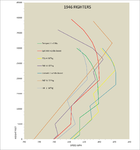wuzak
Captain
For comparison between single stage and 2 stage engine aircraft:
Spitfire XII: 392mph @ 24,000ft
Spitfire XIV prototype (Mk VIIIG): 440mph @ 24,000ft, 421mph @ 39,000ft.
Perhaps not a fair comparison....
The XII was restricted to a maximum of +12psi boost.


